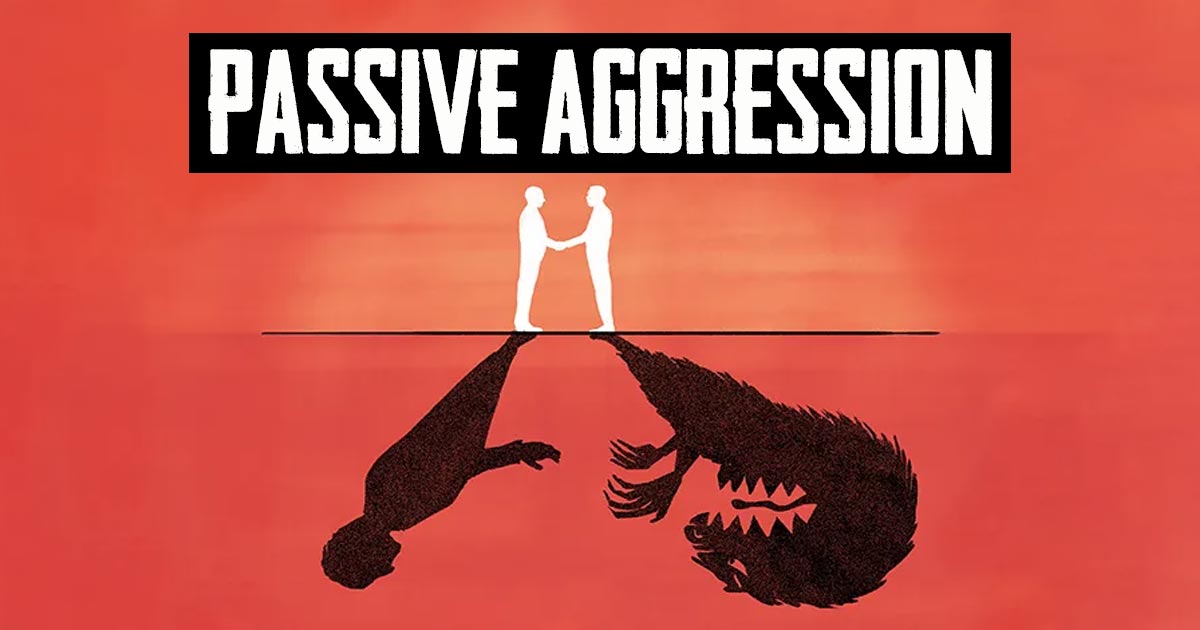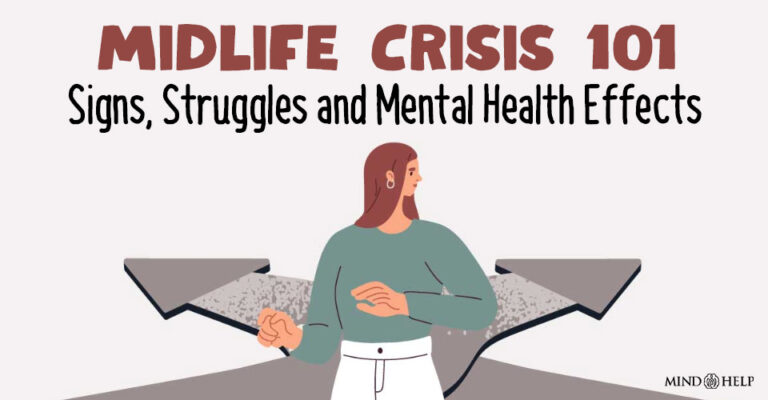Table of Contents
Passive aggression involves the indirect expression of anger, frustration, or hostility through subtle acts of resistance, avoidance, or undermining behaviors. This behavior can have negative consequences on relationships, leading to increased tension and hindering effective communication, making it important to address and navigate these behaviors for coping with passive aggression and promoting healthier interactions.
What is Passive Aggression?
Passive-aggressive behavior refers to actions 1 Hopwood, C. J., Morey, L. C., Markowitz, J. C., Pinto, A., Skodol, A. E., Gunderson, J. G., Zanarini, M. C., Shea, M. T., Yen, S., McGlashan, T. H., Ansell, E. B., Grilo, C. M., & Sanislow, C. A. (2009). The construct validity of passive-aggressive personality disorder. Psychiatry, 72(3), 256–267. https://doi.org/10.1521/psyc.2009.72.3.256 that may appear harmless or neutral but have an underlying aggressive motive. Unlike direct aggression, individuals with symptoms of passive aggression express their control or resistance indirectly, often through behaviors like procrastination, sullenness, or stubbornness, allowing them to exert control in less obvious ways compared to overtly aggressive individuals.
Read More About Procrastination Here
Research indicates that men tend 2 Im, S., Jin, G., Jeong, J., Yeom, J., Jekal, J., Lee, S. I., Cho, J. A., Lee, S., Lee, Y., Kim, D. H., Bae, M., Heo, J., Moon, C., & Lee, C. H. (2018). Gender Differences in Aggression-related Responses on EEG and ECG. Experimental neurobiology, 27(6), 526–538. https://doi.org/10.5607/en.2018.27.6.526 to score higher in passive aggression compared to women, and a significant portion of individuals, specifically 73% 3 Girasek, H., Nagy, V. A., Fekete, S., Ungvari, G. S., & Gazdag, G. (2022). Prevalence and correlates of aggressive behavior in psychiatric inpatient populations. World journal of psychiatry, 12(1), 1–23. https://doi.org/10.5498/wjp.v12.i1.1 , experience passive-aggressive communication in the workplace, with 52% encountering it on a weekly basis. Such behavior can have detrimental effects on relationships, leaving recipients feeling frustrated and powerless as they struggle to elicit cooperation.
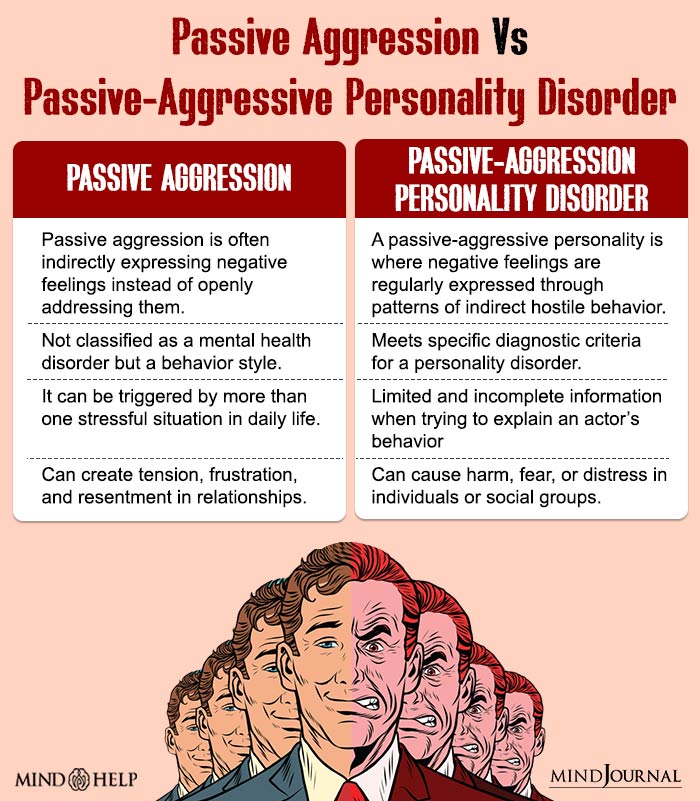
Signs of Passive Aggression
Some common signs of passive-aggressive behavior include:
- Sulking, giving silent treatment, or refusing to communicate openly.
- Indirect or backhanded compliments that include hidden criticism or insults.
- Procrastination and intentional delays in fulfilling obligations or tasks.
- Frequently complaining, but not taking any action to resolve the source of the complaint.
- Expressing resentment or anger through subtle actions, such as slamming doors, moving things around loudly, etc.
- Denying their anger as a way to avoid direct confrontation and the discomfort associated with those emotions.
- A habit of blaming others for problems.
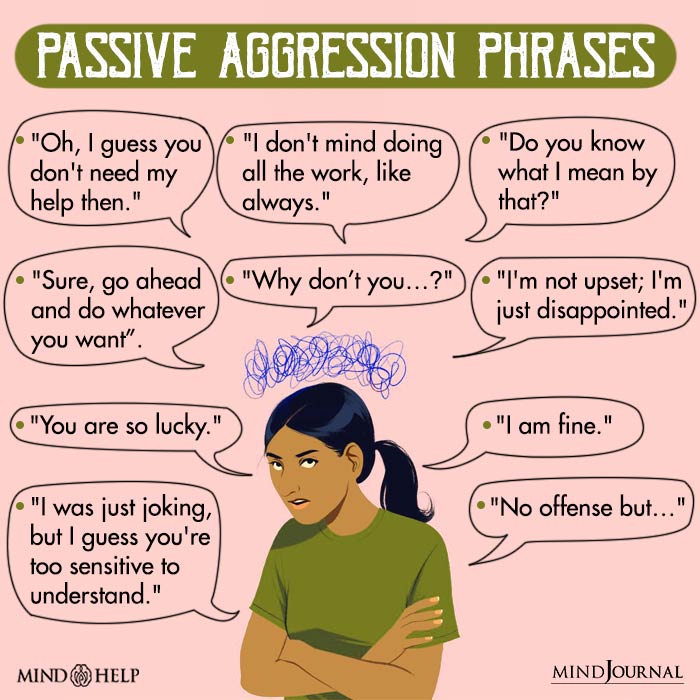
How Passive Aggression Affects Mental Health
It is important to note that the effects 4 Schanz, C. G., Equit, M., Schäfer, S. K., & Michael, T. (2022). Self-directed passive-aggressive behaviour as an essential component of depression: findings from two cross-sectional observational studies. BMC psychiatry, 22(1), 200. https://doi.org/10.1186/s12888-022-03850-1 can vary depending on the severity and frequency of the symptoms of passive aggression that lead to:
- Elevated levels of stress and constant tension in relationships as individuals with passive aggression try to avoid addressing and resolving conflicts.
- Trust issues while passive aggression create an atmosphere of uncertainty and undermine open and honest communication.
- Low self-esteem and negative self-image are the indirect criticism associated with passive-aggressive behavior.
- Development of depressive symptoms for prolonged experiencing passive aggression such as sadness, loss of interest or pleasure, and feelings of worthlessness or guilt.
- The development of anxiety through unpredictable communication, constant tension, and a sense of uncertainty, leads to increased worry, restlessness, and irritability.
Read More About Self-Esteem Here
What Causes of Passive Aggression
Passive-aggressive behavior can have various causes 5 Passive aggressive personality disorder (Concept Id: C0030631) – MedGen – NCBI. (n.d.). Www.ncbi.nlm.nih.gov. Retrieved July 14, 2023, from Available from: https://www.ncbi.nlm.nih.gov/medgen/18319 and may stem from a combination of different factors, such as:
- Learned behavior modeling by significant others, such as parents or caregivers.
- A fear of confrontation or negative consequences is associated with expressing true feelings openly, leading to indirect communication.
- Individuals who have grown up in environments where direct expression of emotions was discouraged or punished may develop passive-aggressive tendencies.
- Stressful or conflict-prone environments, such as dysfunctional families or toxic workplaces, can foster passive-aggressive behavior as a coping mechanism.
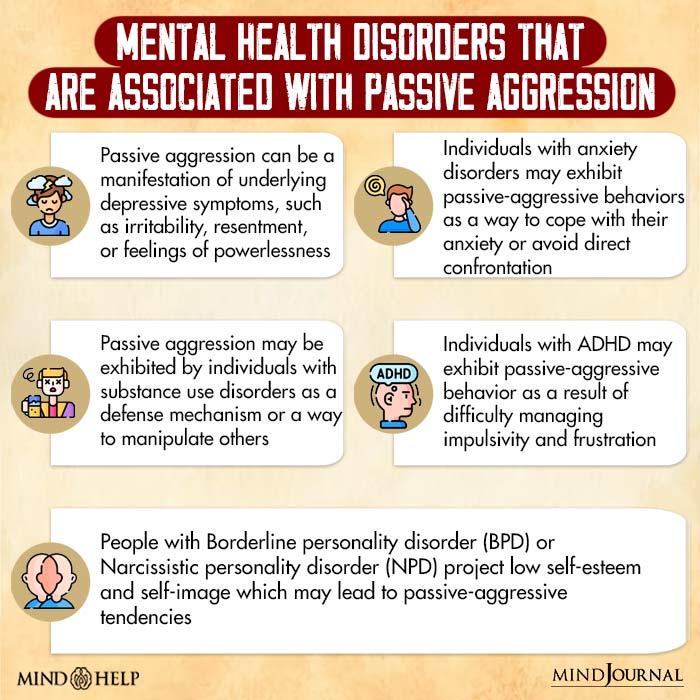
How to Diagnose Passive Aggression
Passive aggression is not formally recognized as a diagnostic category in DSM-5. Instead, it is considered a pattern of behavior or a communication style that can be observed and assessed based on:
- Identifying the behavior patterns such as indirect expressions of negative feelings, avoidance of direct communication, or subtle acts of resistance.
- Gathering information about the individual’s behavior, emotions, and interpersonal relationships through clinical interviews by mental health professionals.
- Using psychological assessments, such as personality inventories or anger management scales to evaluate traits associated with passive aggression.
Treatment for Passive Aggression
Therapeutic interventions and medications are utilized to treat common 6 Perry, J. C., & Flannery, R. B. (1982). Passive-aggressive personality disorder. Treatment implications of a clinical typology. The Journal of nervous and mental disease, 170(3), 164–173. https://doi.org/10.1097/00005053-198203000-00005 conditions of passive aggression which include:
1. Medications
Medications such as antianxiety medications, mood stabilizers, etc. may be prescribed by mental health professionals to address underlying conditions such as depression, anxiety, or mood disorders that can contribute to passive-aggressive tendencies.
Read More About Depression Here
2. Cognitive-Behavioral Therapy (CBT)
CBT helps individuals 7 Chand, S. P., Kuckel, D. P., & Huecker, M. R. (2022, September 9). Cognitive Behavior Therapy (CBT). National Library of Medicine; StatPearls Publishing. Available from: https://www.ncbi.nlm.nih.gov/books/NBK470241/ recognize and change negative thought patterns and behaviors for overcoming passive aggression. It can help identify underlying beliefs and attitudes that contribute to the symptoms of passive aggression and develop more assertive communication skills.
Read More About Cognitive Behavioral Therapy (CBT) Here
3. Anger Management
Since passive aggression can be rooted in unresolved anger 8 Steffgen G. (2017). Anger Management – Evaluation of a Cognitive-Behavioral Training Program for Table Tennis Players. Journal of human kinetics, 55, 65–73. https://doi.org/10.1515/hukin-2017-0006 , anger management techniques may be helpful. This involves learning healthy ways to express anger, manage frustration, and develop strategies to cope with passive aggression.
Read More About Anger Management Here
How to Deal with Passive Aggression
Here are some tips 9 Schanz, C. G., Equit, M., Schäfer, S. K., & Michael, T. (2022). Self-directed passive-aggressive behaviour as an essential component of depression: findings from two cross-sectional observational studies. BMC psychiatry, 22(1), 200. https://doi.org/10.1186/s12888-022-03850-1 to deal with individuals with passive aggression:
- Try to recognize the specific manifestations of passive aggression within an individual, such as self-deprecation or silent resentment, etc.
- Try to stay composed and avoid being drawn into their game of subtle provocation or manipulation.
- Clearly express your expectations, boundaries, and feelings in a calm and assertive manner.
- Practice active listening and try to understand their underlying emotions and concerns.
- Extend an offer to work collaboratively and find a mutually satisfactory resolution for passive aggression.
- Encourage and appreciate the person’s ability to express emotions directly, rather than relying on passive-aggressive tactics.
- If necessary, seek support from trusted friends, family, or professionals to help you navigate the challenges of dealing with passive aggression.
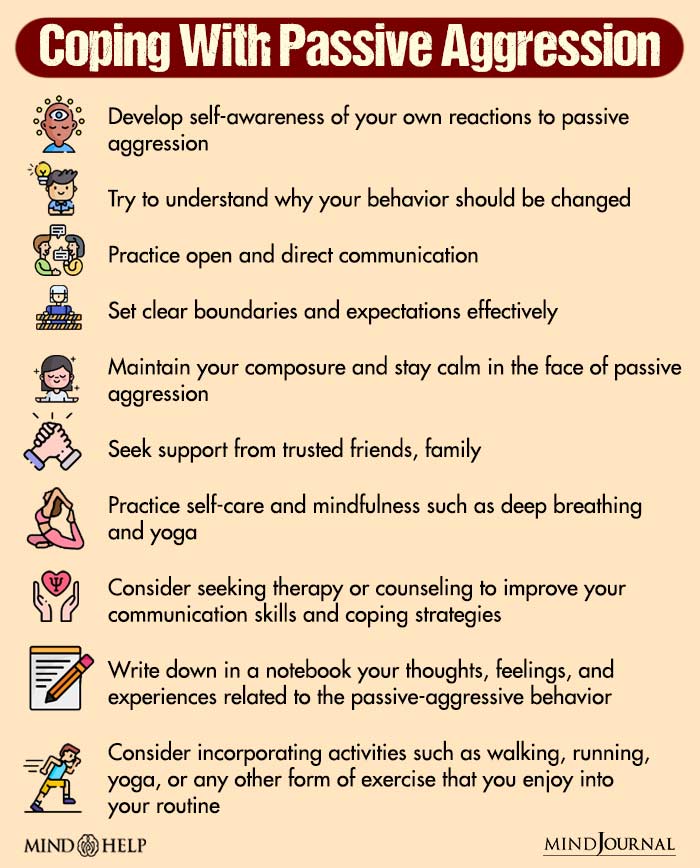
Takeaway
Understanding and addressing passive-aggressive behavior involves recognizing the signs, setting clear boundaries, and promoting open and direct communication. By addressing the underlying issues, fostering healthier patterns of interaction, and prioritizing open dialogue, an individual can navigate conflicts more effectively and promote positive and respectful relationships.
At A Glance
- Passive aggression is a behavior characterized by indirect resistance, negativity, and avoidance of direct confrontation.
- Common signs of passive aggression include using sarcastic remarks or comments, refusing to communicate with someone, etc.
- Passive aggression can lead to elevated levels of stress and constant tension and other mental health disorders.
- Passive-aggressive behavior can be learned from others or stressful or conflict-prone environments.
- Passive aggression is assessed by clinical interviews and the application of standardized psychological assessments.
- Treatment for passive aggression typically involves a combination of therapeutic approaches and medication aimed at addressing underlying issues.
- Reinforcing positive behavior, fostering empathy, and addressing underlying issues are key strategies for overcoming passive aggression.
Frequently Asked Questions (FAQs)
1. Is passive aggression abuse?
If passive aggression is consistently and frequently exhibited within a relationship, it can be regarded as a form of abuse due to the ongoing emotional harm and the negative impact on the individuals involved.
2. How does a parent’s passive aggression affect their child?
Children raised by passive-aggressive parents may be more prone to adopting similar behaviors, affecting their own relationships. They often struggle to form close friendships and intimate connections, frequently withdrawing during conflicts, which can upset others and create distance between them.
3. What is the best way to respond to passive aggression?
The best way to respond to passive aggression is to stay calm, address the behavior directly, set clear boundaries, encourage open communication, and seek support if needed.

